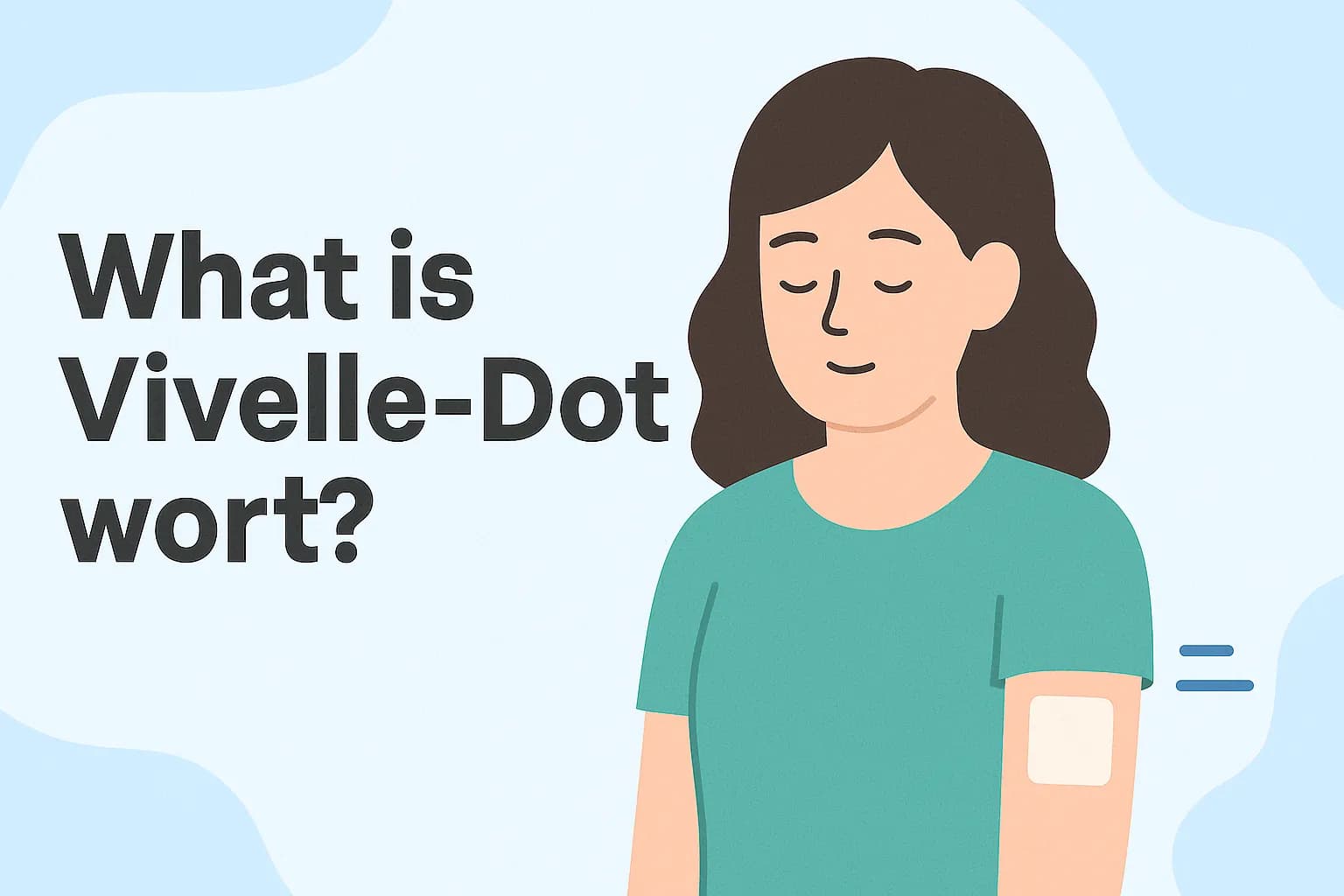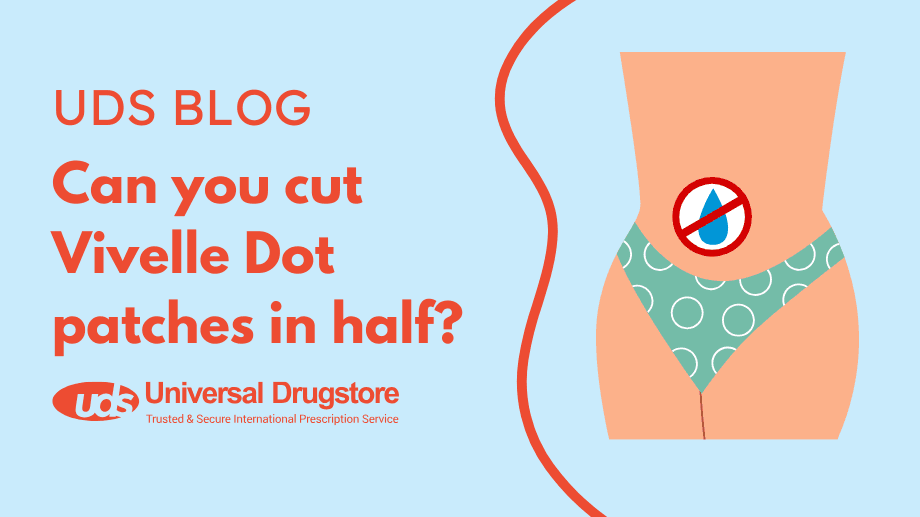Is Vivelle-Dot being discontinued?

Vivelle-Dot (estradiol transdermal system) is a brand-name transdermal hormone replacement therapy (HRT) patch that delivers estradiol, a form of estrogen, through the skin into your bloodstream. It is used to treat symptoms of menopause and prevent osteoporosis in postmenopausal women.
According to the Drugs website, the Vivelle brand has been discontinued. There are several generic versions of this medication available. Vivelle-Dot is also marketed in Canada under the Estradot brand, which is available through Universal Drugstore (UDS). Talk with your healthcare provider to see if any of these alternatives are right for you.
Read on to learn more about Vivelle-Dot, including its side effects, drug interactions, and precautions. We will also answer some frequently asked questions.
Vivelle-Dot FAQs
What is Vivelle-Dot?
Vivelle-Dot is a transdermal patch that is FDA-approved to increase estrogen levels to treat menopausal symptoms and prevent osteoporosis in postmenopausal women or women without a uterus. When prescribing Vivelle-Dot solely for the treatment of moderate to severe vaginal atrophy, first consider the use of topical vaginal products.
Vivelle-Dot can be started immediately if you are not currently taking oral estrogens or if you are switching from another estrogen patch. If you are currently taking oral estrogens, begin Vivelle-Dot 1 week after discontinuation of your oral estrogen therapy. It can be started sooner if menopausal symptoms reappear in less than 1 week.
What are the side effects of using Vivelle-Dot?
The most common side effects of Vivelle-Dot seen in clinical trials include:
- Headache
- Breast tenderness or pain
- Flu-like symptoms
- Stomach pain
- Fluid retention/swelling
- Body or back pain
- Depression
- Vaginal bleeding or spotting
- Upset stomach
- Weight gain
- Bloating
- Skin redness/irritation at the application site
- Vaginal discharge
- Itching
- Nausea
Other possible side effects of Vivelle-Dot include:
- High blood pressure
- Hot flushes
- Facial hair growth
- Joint pain
- Muscle weakness
- Gas
- Constipation
- Anxiety/nervousness
- Trouble sleeping
- Stuffy nose
- Fungal infections
Rarely, Vivelle-Dot may cause severe side effects such as:
Serious, life-threatening allergic reactions, including anaphylaxis
Symptoms may include hives, skin rash, swelling of your face, lips, tongue, or throat, and shortness of breath. Seek immediate medical attention if you experience any symptoms of a serious allergic reaction.
Increased risk of endometrial cancer
If you have any unusual vaginal bleeding, notify your healthcare provider. Using Vivelle-Dot for more than a year can increase your risk. If you have not had a hysterectomy, you should also take a progestin.
Increased risk of breast cancer
The longer you take Vivelle-Dot, the higher your risk. Use this medication at the lowest dose for the shortest time needed. Additional monitoring may be needed if you have a family history or breast health concerns.
Blood clots, heart attack, and stroke
Seek medical attention if you have pain in your legs or arms, chest pain, severe headaches, trouble breathing, or sudden changes in vision or speech.
Dementia
Risk may be increased, especially if treatment begins after age 65.
Gallbladder problems
Seek care if you experience stomach pain, vomiting, jaundice, or fever.
Pancreatitis
Vivelle-Dot may increase triglycerides. Symptoms of pancreatitis include back pain, nausea, sudden weight loss, or rapid heartbeat.
These are not all of the possible adverse effects of Vivelle-Dot. Always consult a healthcare professional. Read your Medication Guide and report side effects to Novartis at 1-888-669-6682 or to the FDA at 1-800-FDA-1088 or www.fda.gov/medwatch.
What does Vivelle-Dot do?
The active ingredient in Vivelle-Dot is estradiol. It replaces estrogen lost during menopause, which helps relieve symptoms such as hot flashes and vaginal dryness and prevents bone loss. Estradiol is also available in topical emulsions, gels, sprays, and patches.
What should you tell your healthcare provider before using Vivelle-Dot?
You should not take Vivelle-Dot if you are allergic to estradiol or its ingredients. Tell your provider if you have any of the following:
- Unusual vaginal bleeding
- Breast, uterine, or ovarian cancer
- Porphyria or other blood disorders
- Clotting disorders
- Heart disease or prior heart attack/stroke
- Gallbladder, kidney, or liver disease
- Hereditary angioedema
- High cholesterol or triglycerides
- Uterine fibroids or endometriosis
- Migraine headaches
- Hypothyroidism
- Diabetes
- Seizures
- Asthma
- High calcium levels
- Pregnancy or breastfeeding
Are there any drug interactions with Vivelle-Dot?
Tell your healthcare provider about all your medications, including:
- CYP3A4 inducers such as phenobarbital, carbamazepine, rifampin, or St. John’s wort
- CYP3A4 inhibitors such as erythromycin, clarithromycin, ketoconazole, itraconazole, ritonavir, and grapefruit juice
How often do you change Vivelle-Dot?
Apply the patch to a clean, dry area on the stomach or buttocks twice a week. Avoid the breast area and waistline. Hold it firmly for about 10 seconds. Rotate the site each time and avoid reapplying to the same spot within one week. If a patch falls off, reapply or use a new one at a different site while staying on the original schedule.
What hormones are in Vivelle-Dot?
Vivelle-Dot contains estradiol, a form of estrogen. It is used to treat menopausal symptoms such as hot flashes, vaginal dryness, and irritation.
Does Vivelle-Dot cause weight gain?
Some users may gain weight. In clinical trials, up to 8.5% of people reported weight gain. If this concerns you, consult your healthcare provider about alternatives.
Where should you apply your Vivelle-Dot patch?
Apply to your lower abdomen or upper buttocks, not the breasts or waistline. Change it every 3 to 4 days. Your provider will guide the correct starting dose.
Related Medications
- Climara (estradiol patch)
- Climara Pro (estradiol/levonorgestrel)
- Alora Patches (estradiol)
- Minivelle (estradiol patch)
- Menostar (estradiol)



